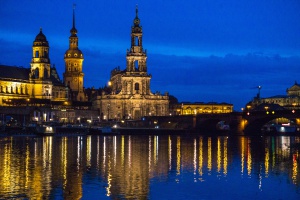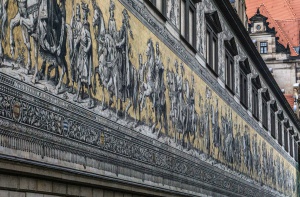Be captivated by its Renaisance and Baroque architecture
Dresden has Mediterranean charm and world-class museums.

ART – Scene in Dresden Dresden was a center of European modern art until 1933. Dresden’s reputation as a top European city of art has been formed to a great extent by the work of visual artists.
useful information: Weather |

Sightseeing Program Frauenkirche: Museums Old Masters Gallery |
Elbe-Florence
Germans like to compare Dresden to Florence due to its rich Renaissance and Baroque architecture, its museums, its music heritage and because of its temperate climate, which allows for Germanys most eastern vineries to thrive. The royal buildings are among the most impressive buildings in Dresden. The Castle was the seat of the royal household from 1485. The wings of the building have been renewed, built upon and restored many times. Due to this integration of styles, the castle is made up of elements of the Renaissance, Baroque and Classicist styles. The Zwinger Palace is across the road from the castle. It was built as the center for the royal art collections and a place to hold festivals. Its gate by the moat, surmounted by a golden crown, is famous
Friedrich Schiller wrote his Ode to Joy for the Dresden Masonic Lodge in 1785. Ludwig van Beethoven used the Ode in the final movement of his Ninth Symphony, which was adopted as the European Anthem in 1992. Carl Maria von Weber and Richard Wagner had a number of their works performed for the first time in Dresden. Other famous artists, such as, Richard Strauss, Gottfried Semper and Gret Palucca, were also active in the city. The Dresdner Kreuzchor (Choir of The Holy Cross) is a boys‘ choir founded in the 13th century. The Semper Opera House, which reopened 40 years after its destruction in 1945, is home to the Sächsische Staatkapelle (Orchester), founded in 1548. History The earliest settlements found around Dresden are from the Neolithic era, about 7500 BC and pre-date Stonehenge by about 4000 years. During the early middle ages the area was settled by Sorbs, an ethnic minority which still cultivates its culture and language in the eastern part of Germany. The Margrave of nearby Meissen chose Dresden as his residence in 1206. From 1485 it was the seat of the dukes of Saxony. In the 1550s Frederick Augustus I was both Elector of Saxony and King of Poland (August the Strong). His reign marked the beginning of Dresden’s emergence as a leading European city for technology and art. Between 1806 and 1918 the city was the capital of the Kingdom of Saxony. Dresden was one center of the German Revolution in 1848. The May Uprising severely damaged the historic centre of Dresden. During the 19th century the city became a major industrial center, including cigarette production, food processing, banking and the manufacture of medical equipment. In the 20th century Dresden was a major communications hub and particularly well known for its camera works until its destruction on 13 February 1945. Kurt Vonnegut’s novel Slaughterhouse Five is loosely based on his first-hand experience of the raid as a POW. After the Second World War, Dresden became a major industrial center in the German Democratic Republic. Many important historic buildings were rebuilt, including the Semper Opera House, the Zwinger Palace and a great many other historic buildings. However, the authorities chose to reconstruct large areas of the city in a „socialist modern“ style, to break away from the city’s past as the royal capital of Saxony and a stronghold of the German bourgeoisie. In 1989 local activists and residents joined in the growing civil disobedience movement spreading across East Germany by staging demonstrations and demanding the removal of the nondemocratic government. Dresden has experienced dramatic changes since the reunification in the early 1990s. The city still bears many wounds from the bombing raids of 1945, but it has undergone significant reconstruction in recent decades. Restoration of the Frauenkirche was completed in 2005, a year before Dresden’s 800th anniversary, notably by privately raised funds. |

